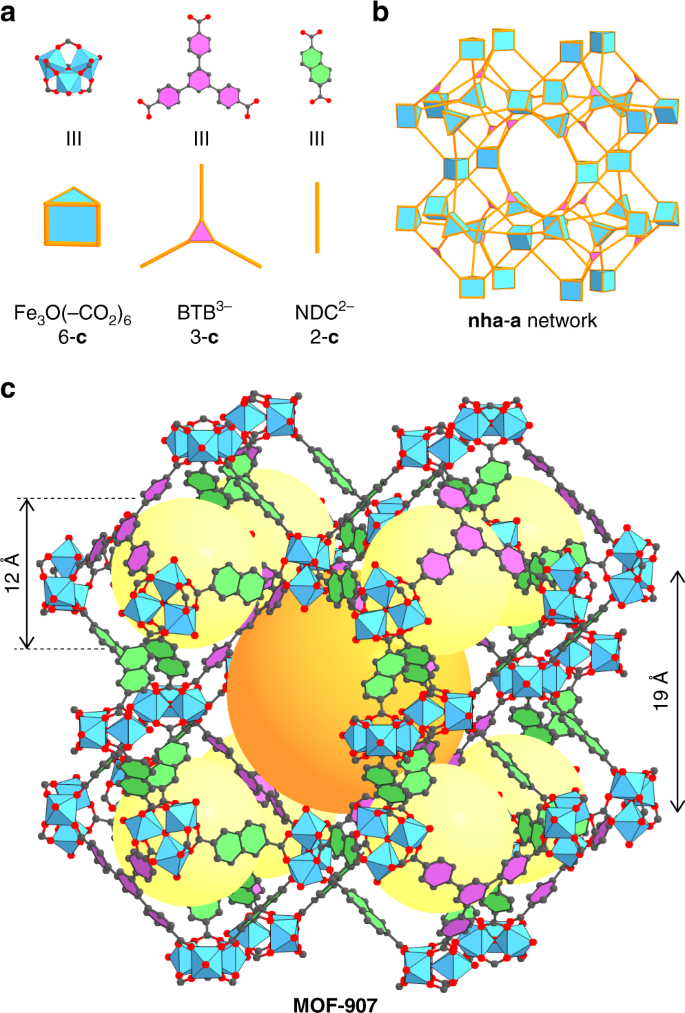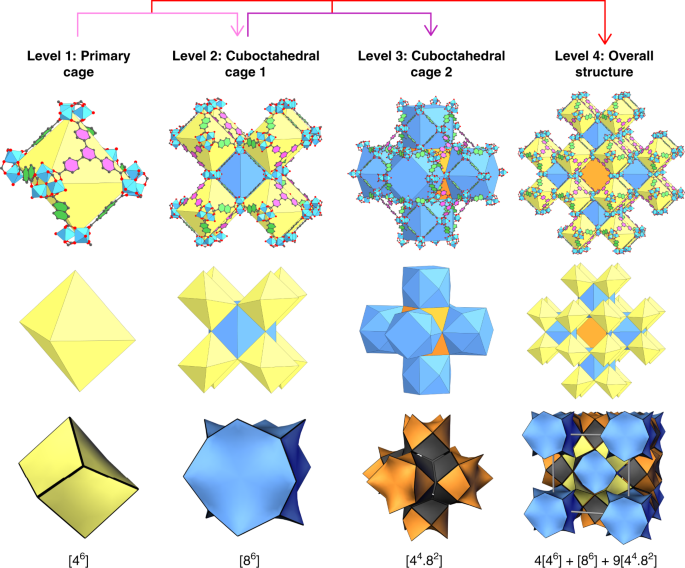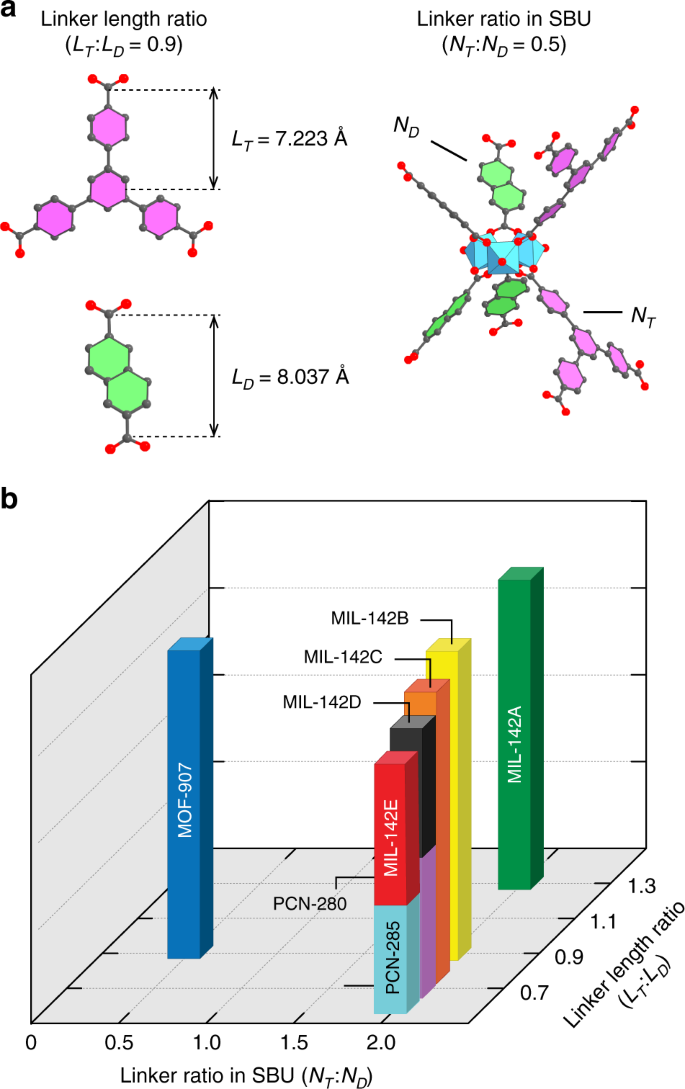Researchgate – Tam Huu Nguyen
Metal-organic frameworks (MOFs) have emerged as promising materials for use in practical applications of renewable energy, water harvesting, and catalytic transformation. Here we report the design of a highly porous MOF, termed MOF-907. Single crystal X-ray diffraction analysis, in combination with topological deconstruction, revealed a MOF based on trigonal prismatic secondary building units linked together by triangular and linear units to form a previously unseen net (nha) with minimal transitivity, which is rational for these constituent building units. The catalytic properties of MOF-907 for the microwave-assisted radical polymerization of methyl methacrylate were demonstrated. MOF-907 produced a poly methyl methacrylate product in a short reaction time (30 min) with high yield (98%), high molecular weight (20,680 g mol−1), and low polydispersity (1.23).
Đang xem: Researchgate
It is a central premise of reticular chemistry that structures of the highest symmetry (i.e., minimal transitivity) are the most likely to result from linking simple, symmetric building units1,2,3,4. This notion holds true for metal-organic frameworks (MOFs)5 whose structures are simple in that they contain one kind of multi-metallic unit and one kind of organic linker. However, the premise of minimal transitivity is not as widely observed for more complex MOFs whose compositions extend beyond binary building units6,7,8,9,10. This is because the ratios of linkers incorporated within such MOF structures and their respective length ratios must be a perfect match. Indeed, this becomes increasingly difficult to control when moving toward multiple building units. Given the desire to increase the complexity of MOFs (i.e., increase the number of building units)11, the following questions arise: Can the transitivity principle be effectively extended? If so, what are these structures and what are their properties? For the first two questions, we know that complex MOFs constructed from multiple building units rarely follow the minimal transitivity principle (MOF-205 is a notable exception).
In this contribution, we describe a complex ternary MOF system, termed MOF-907, which is constructed from trigonal prismatic Fe3O(–CO2)6 clusters with triangular 4,4′,4”-benzene-1,3,5-triyl-tris(benzoic acid) (H3BTB) and linear 2,6-naphthalenedicarboxylic acid (H2NDC) linkers. For this system, the ideal linker length ratio and linker incorporation is met for achieving a minimal transitive nha net. In addressing the third question, we elucidate the relationship between high symmetry and the favorable geometry of the pore structure within such systems, leading to this material′s enhanced catalytic properties.
Single crystal X-ray diffraction studies
Single crystals of MOF-907 (Fig. 1 and Supplementary Figs. 1 and 2) were obtained upon heating a reaction mixture containing H3BTB, H2NDC, and Fe(NO3)3·9H2O in N,N-dimethylformamide (DMF) at 120 °C for 24 h. Acetic acid, acting as a modulator to adjust the acidity, was also added to the reaction mixture (Supplementary Methods). Single crystal X-ray diffraction analysis revealed that MOF-907 crystallized in the body-centered cubic space group, Im-3m (No. 229), with a lattice parameter of a = 44.4781(14) Å (Supplementary Data 1 and Supplementary Table 1).

Structural representation of MOF-907. (a, b) Trigonal prismatic Fe3O(–CO2)6 clusters linked together by triangular 4,4′,4”-benzene-1,3,5-triyl-tris(benzoate) (BTB3−) and linear 2,6-naphthalenedicarboxylate (NDC2−) linkers, corresponding to 6-connected, 3-connected, and 2-connected (-c) points of extension, respectively, yield a MOF with a previously unseen net, nha (depicted in augmented (-a) form). (c) The single crystal structure of MOF-907 is presented. Atom colors: Fe: blue polyhedra. C: black, and O: red. All H atoms are omitted for clarity. The yellow and orange spheres indicate the free space in the cages
The structure of MOF-907 is made up of four hierarchical levels. These levels can be reduced down to the assembly of a primary cage comprised of six trigonal prismatic Fe3O(–CO2)6 clusters acting as vertices to form a distorted octahedral-shaped cage with a 12 Å diameter (Fig. 2a). In this primary cage, two tritopic BTB3− linkers connect the vertices along opposing equatorial edges with the remaining coordination occurring across the faces to both of the axial vertices. Completing the primary cage are six NDC2− linkers, two of which fill in the remaining equatorial edges and the other four connecting the equatorial vertices with those of the axial sites (on opposing axial edges from the BTB3− axial face). These primary cages then assemble into the second level of the structure, in which each trigonal prismatic vertex of the primary octahedral cage is shared with another primary octahedral cage (Fig. 2a). The second level is created upon assembling eight primary cages into a cuboctahedral-shaped cage with a diameter of 19 Å (cuboctahedral cage 1, Fig. 2a). This gives rise to a square window with a diameter of ~13 Å. A third level is then built up from six cuboctahedral cage 1 units of 19 Å in diameter (cuboctahedral cage 2, Fig. 2a). Finally, the overall structure is realized through combining all three levels: one cuboctahedral cage 2, six cuboctahedral cage 1, and 24 total primary cages generating two types of 1-D interconnected pore channels due to the cubic lattice structure.
Xem thêm: Khách Sạn Victoria

Conceptual basis for the realization of MOF-907 adopting the minimal transitive nha net. This structure is built up from four hierarchical levels. a At the fundamental level, a primary distorted octahedral cage consisting of six Fe3O(–CO2)6 clusters connected by two BTB3− and six NDC2− linkers, is formed. A cuboctahedral cage 1 then assemblies from eight vertex-sharing primary cages. This leads to the assembly of six of these cuboctahedral cages to form another cuboctahedral cage (cage 2). The overall structure then assembles through a combination of one cuboctahedral cage 2, six cuboctahedral cage 1, and 24 total primary cages. b The natural tiling of the nha topology is shown for each of the cages. Atom colors: Fe: blue polyhedral, C: black, and O: red. BTB3− linkers are shown in filled pink to aid in distinguishing them from the NDC2− linkers (filled green). H atoms are omitted for clarity
Topological analysis of MOF-907
Topological deconstruction of MOF-907 was performed using ToposPro software12. For topological analysis, the Fe3O(–CO2)6 secondary building unit (SBU) and BTB3− and NDC2− linkers were first reduced into simplified nodes, resulting in 6-connected and 3-connected points of extension for Fe3O(–CO2)6 and BTB3−, respectively. It is noted that NDC was represented as an edge when connecting the 6-c point of extension for the Fe3O(–CO2)6 nodes. Through this deconstruction, we uncovered the first case of a net, termed nha, with minimal transitivity based on trigonal prismatic SBUs linked together by triangular and linear units (Supplementary Fig. 3). Furthermore, this is only the second complex MOF structure, constructed from mixed linkers, to have adopted a minimal transitive net7. The transitivity of the nha tiling (face-to-face packing of cages) is described in terms of pqrs (where p is the number of vertices, q is the number of edges, r is the number of faces, and s is the type of tiles). For nha, pqrs = 2244. Further analysis of the tiling reveals three cages described as 4<46> + <86> + 9<44.82>, respectively (where the symbol <…mn…> denotes that there are n faces with m-membered rings) (Fig. 2b).
When considering the reason for realizing the nha net, it was evident that the ratio of the tritopic:ditopic linker lengths (LT:LD; where LT = length of the tritopic linker and LD = length of the ditopic linker) played a critical role. Minimal transitive nets are achieved with the highest frequency for MOFs constructed with only one linker because they are the most symmetric. However, for the case of MOFs constructed from two (or more) linkers, the relative ratio of linker lengths must be a perfect fit to achieve maximal symmetry. Based on crystal structure evaluation and analyses, we observed that the ratio of linker lengths for MOF-907 (LT:LD = 0.90) achieves this in contrast to other MOFs with similar constituent building units: MIL-142A (LT:LD = 1.29), PCN-280 (LT:LD = 0.71), and PCN-285 (LT:LD = 0.59) (Fig. 3a and Supplementary Fig. 4). Upon further investigation into the reasoning behind MOF-907 adopting a minimal transitive net, we identified a second structural phenomenon: the ratio of the tritopic:ditopic linkers (NT:ND; where NT = the number of tritopic linkers and ND = the number of ditopic linkers) connected to the Fe3O SBU was variable. In fact, we found that there were three possible ratios when considering this structural phenomenon in Fe-based MOFs with the same constituent building units: (i) 4 tritopic and 2 ditopic linkers (NT:ND = 2; ex. PCN-285, PCN-280, and MIL-142A-E); (ii) 3 tritopic and 3 ditopic linkers (NT:ND = 1); and (iii) 2 tritopic and 4 ditopic linkers (NT:ND = 0.5; ex. MOF-907) (Fig. 3). As such, we found that MOF-907 had perfectly-sized tritopic and ditopic linkers (LT:LD = 0.90) and combination thereof incorporated within the SBU (NT:ND = 0.5), which led to the realization of the highest symmetry minimal transitive network for MOFs comprised of these building units (Fig. 3). It is noted that an optimal input ratio of starting materials (molar ratio of BTB:NDC = 0.5–0.75) together with an exact amount of modulator (AcOH, 0.2 mL) were required to produce the resulting structure during crystal formation.

Principles for achieving minimal transitivity in MOF-907. a Two structural features played pivotal roles in producing MOF-907, which adopts a highly symmetric, minimal transitive net: The ratio of tritopic:ditopic linker lengths (LT:LD); and the proportion of tritopic to ditopic linker incorporated within the SBU (NT:ND). b These structural features are guiding principles for achieving the highest symmetric material based on Fe3O SBUs and mixed tritopic and ditopic linkers
After solvent-exchange and full activation, the activated sample was measured powder X-ray diffraction (PXRD) which is in agreement with the as-synthesized and simulated pattern (Supplementary Fig. 5). The formulation of the chemical structure was achieved through a combination of digested 1H nuclear magnetic resonance spectroscopy (NMR), elemental microanalysis (EA), thermal gravimetric analysis (TGA), Mössbauer spectroscopy, and Fourier transform infrared spectroscopy (FT-IR) measurements (Supplementary Figs. 6–8). The digested 1H NMR spectrum confirmed the ratio of BTB:NDC to be 1:3 (Supplementary Fig. 11). Following this, EA was employed to resolve MOF-907′s chemical formula as FeIII3O(OH)(BTB)0.67(NDC)2. TGA was then utilized to provide further support for this formulation. After heating activated MOF-907 in air up to 600 °C, the observed residual mass (22.3%) was consistent with the expected mass of Fe2O3 (23.4%) after framework decomposition. The presence of one capping OH− ligand (necessary for charge balancing) was proven by FT-IR, where an O-H stretching frequency vibration at 520 cm–1 was clearly observed (Supplementary Fig. 7)13, 14. To ensure the oxidation state of Fe in MOF-907 was correct, Mössbauer spectroscopy was employed to confirm the presence of only FeIII within the structure (Supplementary Fig. 8). Finally, the permanent porosity of MOF-907 was proven by N2 adsorption isotherms at 77 K. MOF-907 exhibited a Brunauer−Emmett−Teller (Langmuir) surface area of 1600 (1800) m2 g–1 (Supplementary Figs. 9 and 10), which is slightly less than the theoretical geometrical surface area determined from the crystal structure (2000 m2 g–1).
Xem thêm: Biệt Thự Thiên Đường Bảo Sơn Tháng 03/2021, Bán Biệt Thự Thiên Đường Bảo Sơn
Catalytic properties of MOF-907
Motivated by the high porosity and appropriately-sized 1-D interconnected pore channels of MOF-907 in conjunction with the presence of strong Lewis acidity via potential coordinatively unsaturated metal sites in the Fe3O SBUs15,16,17, we sought to assess whether such a structure would have, as a natural outcome, a high performance for catalytic applications. As such, MOF-907 was employed as a catalyst for the microwave-assisted radical polymerization of methyl methacrylate (MMA; Fig. 4)–a model reaction that requires a catalyst with strong Lewis acidity18, 19. Initial attention was placed on optimizing the catalysis conditions, including the amount of MOF-907 catalyst, co-initiator, organic solvent, and reaction time. As such, two different co-initiators, ethyl α-bromophenylacetate (EBPA) and ethyl α-bromoisobutyrate (EBiB), were tested (Supplementary Fig. 12). For the reactions using EBiB, polyMMA was produced in a yield of 68% using MOF-907 catalyst (0.06 mol% loading), with an average Mn = 15,550 g mol–1 and a polydispersity index (PDI) of 1.31. When EBPA was used as the co-initiator, polyMMA formed in lower yield (43%) and with an overall lower Mn (14,230 g mol–1) and higher PDI (1.43) (Table 1 and Supplementary Table 2 and Supplementary Fig. 13).






Bình luận